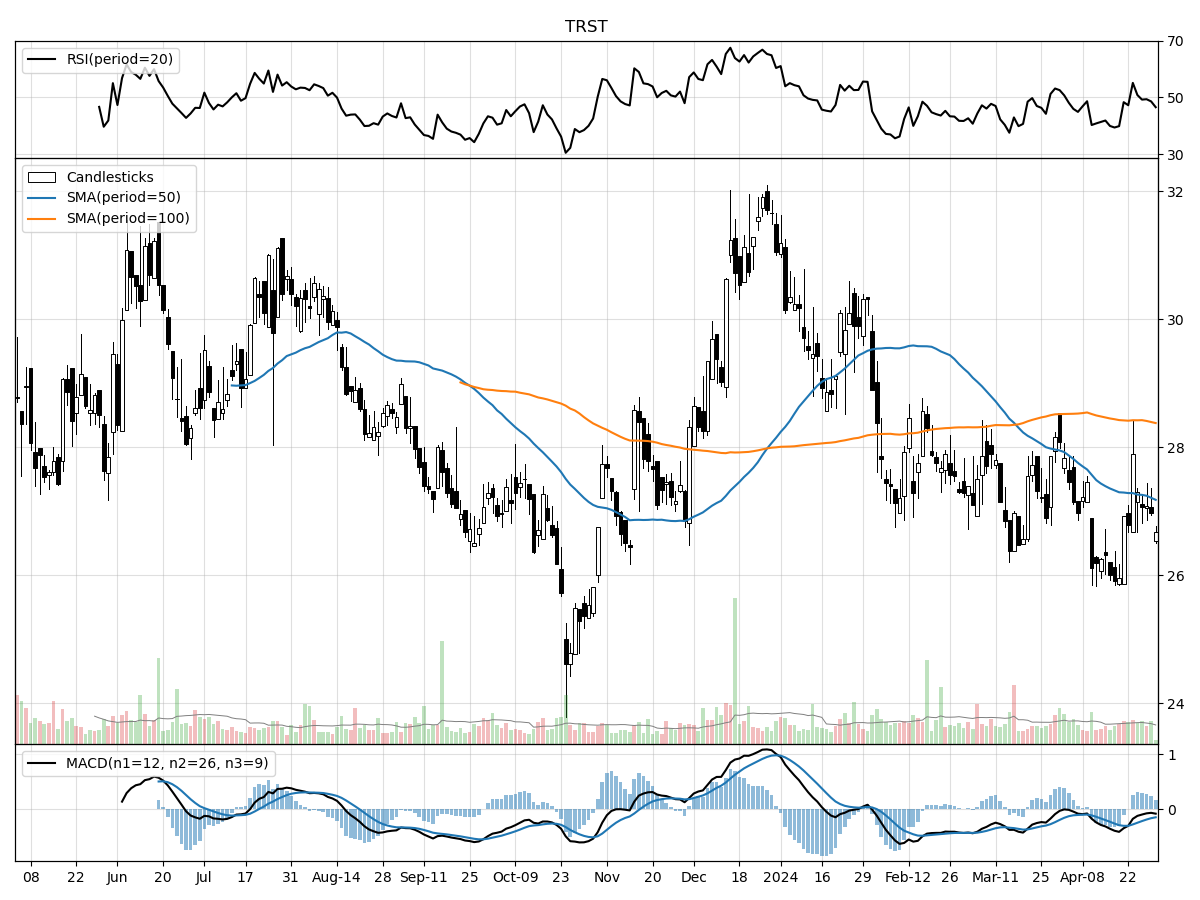Trust Bank Corp (TRST), Mid/Small Cap AI Study of the Week

May 2nd, 2024
Weekly AI Pick from the S&P 500
Company Overview
TrustCo Bank Corp NY, a savings and loan holding company founded in 1981 and based in Glenville, New York, operates through its principal subsidiary, Trustco Bank, which offers a range of banking, trust, and investment services. As of the end of 2023, Trustco Bank has a network of 140 banking offices and 156 ATMs, with assets under management of approximately $967 million. The bank competes with various financial institutions and expects increased competition due to changes in legislation, regulation, and technology. TrustCo and its subsidiaries adhere to regulations from the Federal Reserve Board, the OCC, and the FDIC, and have benefited from the Economic Growth, Regulatory Relief, and Consumer Protection Act, which introduced a simpler "Community Bank Leverage Ratio" of 9%, although TrustCo has not opted into this framework.
The bank's revenue is mainly derived from dividends from its subsidiary, which is subject to regulatory constraints. TrustCo Bank Corp NY and its subsidiary bank maintain capital ratios above regulatory minimums, ensuring they are well-capitalized and can avoid restrictions on dividends and other distributions. The bank applies various risk weights to mortgages and securities, as defined by the Basel III framework, which standardizes these weights. TrustCo Bank's classification as "well capitalized" allows it to operate with fewer restrictions, and as a holding company, TrustCo is limited in its investments and is required to support its banking subsidiaries financially.
TrustCo Bank Corp NY complies with the Dodd-Frank Act and other federal banking regulations, and its common stock is registered with the SEC, mandating strict reporting and governance standards. The bank's deposits are FDIC-insured, with premiums based on risk, and it has been rated "satisfactory" under the Community Reinvestment Act, indicating effective service to its communities. The bank follows guidance on commercial real estate lending and manages risks associated with economic challenges. TrustCo must also pass regulatory tests like the QTL or DBLA to avoid operational restrictions and manage transactions with affiliates within legal limits. These regulations and compliance measures are crucial for the bank's unrestricted operation and management of lending and investment activities.
By the Numbers
Net income: $14.7 million in Q3 2023, down from $19.4 million in Q3 2022.
- Diluted earnings per share: $0.77 in Q3 2023, down from $1.01 in Q3 2022.
- Net interest income: Decreased by $5.6 million in Q3 2023.
- Noninterest expenses: Increased by $1.3 million in Q3 2023.
- Net interest margin: 2.85% in Q3 2023, a decrease of 31 basis points from the previous year.
- Average balance of short-term investments: Decreased by $424.3 million.
- Interest income: Increased by $1.5 million, from $49.0 million to $57.6 million.
- Loan portfolio growth: $337.6 million increase.
- Loan yields: Increased by 32 basis points.
- Securities available for sale portfolio: Decreased by $31.0 million.
- Average savings and money market balances: Declined.
- Total time deposits: $1,581,504 thousand.
- Short-term borrowing averages: Decreased.
- Borrowing rates: Increased.
- Taxable equivalent net interest income: Decreased in Q3, increased over the nine-month period.
- Nonperforming assets: Slight increase.
- Allowance for loan losses: $47.2 million as of September 30, 2023.
- Noninterest income: $4.6 million in Q3 2023.
- Noninterest expenses: $27.5 million in Q3 2023.
- Income tax expense: $4.6 million in Q3 2023.
- Effective tax rate: 23.7% for Q3 2023.
- Total shareholder's equity: $623.9 million as of September 30, 2023.
Stock Performance and Technical Analysis

Based on the provided technicals, the stock is trading at $26.68, which is relatively close to its 52-week low, sitting 8 percent above it. This could suggest that the stock might be currently undervalued or that it is experiencing a downward trend. However, being 16 percent below its 52-week high indicates that the stock has retreated from its peak, and there may be potential for recovery if market conditions are favorable and if the company's fundamentals are strong.
The daily trading volume is an important liquidity indicator. The recent daily volume of 67,154.25 shares is lower than the longer-term average of 79,674.15 shares, which might indicate decreased interest from investors or lower liquidity, potentially making the stock more vulnerable to volatility. Nonetheless, the price stability over the past month and three months suggests that despite the lower volume, the price has not been subject to extreme fluctuations. This could be interpreted as a sign of market consensus about the stock's value within its current trading range.
The Money Flow indicators provide insight into the stock's buying and selling pressure. With the stock under moderate buying pressure, it suggests that investors are showing some interest in acquiring shares, which could be a positive sign for the stock's near-term price movement. However, the mention that the stock is also under distribution indicates that some investors are selling their shares, which can be a signal of a lack of confidence in the stock's short-term growth potential. The bearish Moving Average Convergence Divergence (MACD) of -0.14 reinforces this caution, as it suggests that the stock is currently on a downward momentum trend.
Overall, the mixed signals from the technical indicators suggest that investors should proceed with caution. It would be prudent to analyze the company's fundamentals, market position, and any recent news or events that could affect its stock price before making an investment decision. The bearish MACD should be weighed against the moderate buying pressure and price stability to determine whether the stock's current price represents a buying opportunity or if it's a precursor to further declines.

The ‘Bull’ Perspective
Summary:
- Robust Capital Ratios: TrustCo maintains a strong capital position with total shareholder's equity at $623.9 million, signaling financial stability and resilience.
- Conservative Banking Approach: TrustCo's focus on traditional banking services and avoidance of high-risk loans shields it from volatile market conditions.
- Loan Portfolio Growth: The bank's loan portfolio exhibited growth of $337.6 million, with higher interest rates on new loans enhancing profitability.
- Diversified Income Streams: Despite a challenging environment, TrustCo reported increases in financial services income, showcasing the diversity of its revenue sources.
- Effective Risk Management: TrustCo's identification of risks and active management strategies demonstrate a commitment to mitigating potential financial impacts.
Elaboration:
- Robust Capital Ratios:
TrustCo Bank Corp NY's total shareholder's equity stands at an impressive $623.9 million, a testament to its robust capital management strategy. In the context of the recent economic downturn and increasing regulatory scrutiny, this level of capitalization is not just reassuring; it's an indicator of TrustCo's capacity to weather financial storms. Furthermore, such a strong equity position provides TrustCo with the flexibility to pursue growth opportunities without compromising on financial security. It's essential to highlight that in times of economic uncertainty, a bank's capital adequacy is a critical measure of its health and long-term viability. TrustCo's capital ratios outshine many of its regional peers, making it a potentially safer investment in a sector fraught with challenges. - Conservative Banking Approach:
In a financial landscape riddled with risks from rising interest rates and inflationary pressures, TrustCo's conservative banking approach stands out as a beacon of prudence. By focusing on traditional banking services and steering clear of speculative high-risk loans and investments, TrustCo mitigates the risk of significant loan defaults and investment losses. This strategy is particularly prudent given the recent bank failures and increased regulatory scrutiny within the sector. TrustCo's emphasis on residential real estate loans, which are less volatile and more predictable, provides a stable foundation for its lending business. This conservative approach may not yield the high returns of riskier strategies, but it offers investors a measure of safety and predictability that is invaluable in today's volatile market. - Loan Portfolio Growth:
The growth of TrustCo's loan portfolio by $337.6 million is a robust indicator of the bank's ability to expand its lending activities even in a challenging economic climate. The increase in loan yields by 32 basis points reflects the bank's adeptness at capitalizing on higher interest rates to enhance its interest income. This strategic growth in lending, particularly in the residential real estate sector, is a positive sign for investors looking for stable and growing returns. It's also worth noting that a growing loan portfolio, when managed effectively, contributes to a diversified asset base, which is critical for risk management and long-term sustainability. - Diversified Income Streams:
The ability to generate revenue from multiple sources is crucial for any financial institution, and TrustCo has demonstrated this with an increase in financial services income. This diversification helps buffer the bank against downturns in any single area of its business. For instance, when service fees decreased, the rise in financial services income helped offset the impact on the bank's overall noninterest income, which stood at $4.6 million for the third quarter of 2023. This resilience in the face of sector-specific headwinds underscores TrustCo's adaptability and the strategic foresight of its management team. - Effective Risk Management:
Risk management is at the heart of TrustCo's operations. The bank's clear identification of potential risks, ranging from interest rate fluctuations to liquidity challenges and regulatory compliance, demonstrates a proactive approach to safeguarding its financial health. TrustCo's active management of its loan portfolio, liquidity measures, and capital adequacy, coupled with its conservative approach to banking, positions it well to manage these risks effectively. For investors, this focus on risk management is a reassuring sign that the bank is not only aware of potential pitfalls but is also actively working to mitigate their impact.
Conclusion:
In summary, TrustCo Bank Corp NY presents a compelling case for investment. Its strong capitalization, conservative risk profile, strategic loan portfolio growth, diversified income streams, and proactive risk management collectively paint a picture of a financial institution that is not only stable but also strategically positioned for sustainable growth. While the current economic environment poses undeniable challenges, TrustCo's prudent approach and solid financial metrics suggest it is well-equipped to navigate these challenges and emerge stronger. Investors seeking a resilient addition to their portfolio in the banking sector would do well to consider TrustCo Bank Corp NY as a viable candidate.

The ‘Bear’ Perspective
Before considering an investment in TrustCo Bank Corp NY (TRST), potential investors should be aware of several key factors that could impact the company's future performance. Here is a summary of the main points:
- Declining Net Income and Earnings Per Share: TrustCo's net income has decreased to $14.7 million, with diluted earnings per share falling from $1.01 to $0.77.
- Interest Rate Sensitivity and Inverted Yield Curve: The bank's net interest margin contracted to 2.85%, reflecting the challenging interest rate environment and the potential for further margin compression.
- Increased Nonperforming Assets: A slight rise in nonperforming assets, primarily residential real estate loans, indicates potential future credit risks.
- Regulatory and Economic Uncertainties: Ongoing regulatory changes and global economic uncertainties could negatively affect TrustCo's operations and profitability.
- Dependence on Interest Income: With a significant portion of TrustCo's income reliant on interest-earning activities, the current economic climate poses a substantial risk to its financial stability.
Elaboration on Key Points:
- Declining Net Income and Earnings Per Share
TrustCo's financial performance has shown signs of strain, with a marked decrease in net income to $14.7 million, down from $19.4 million year-over-year. This decline has directly impacted shareholders, as reflected in the drop in diluted earnings per share from $1.01 to $0.77. Such a downward trend in profitability metrics can be unsettling for investors, particularly if it hints at a continuing pattern. Additionally, the bank's return on average assets and equity has also declined, which may suggest a weakening of the overall financial health of the institution. - Interest Rate Sensitivity and Inverted Yield Curve
The bank's net interest margin, a key indicator of financial health for interest-dependent institutions like TrustCo, has contracted to 2.85%. This contraction is notably due to the challenging interest rate environment, with the Federal Reserve's rate hikes affecting borrowing costs. An inverted yield curve, often a harbinger of economic downturns, further exacerbates the situation by potentially signaling future decreases in lending profitability. Investors should be wary of the bank's sensitivity to interest rate fluctuations, as continued pressure could further squeeze margins. - Increased Nonperforming Assets
TrustCo's slight increase in nonperforming assets, particularly in the residential real estate loan portfolio, is a cause for concern. Nonperforming assets are loans on which the borrower is not making interest payments or repaying any principal. While the bank's diversified loan portfolio and active management may mitigate some of the impacts, the rise in nonperforming assets could be indicative of underlying credit risk issues that may manifest in increased provisions for loan losses, thereby affecting future profitability. - Regulatory and Economic Uncertainties
The banking sector is heavily influenced by regulatory changes and global economic conditions. TrustCo, like other regional banks, faces the challenge of adapting to regulatory changes that could increase operating costs and thus reduce profitability. Moreover, geopolitical conflicts, financial market volatility, and the potential for changes in the U.S. government's credit rating could have material adverse effects on the bank's investment and funding transactions. These uncertainties add layers of risk that could deter investment until clearer, more stable conditions emerge. - Dependence on Interest Income
A significant portion of TrustCo's income is derived from interest-earning activities, which are currently under threat from the economic climate characterized by rising interest rates and inflationary pressures. This dependence makes the bank vulnerable to the vagaries of the economic cycle and monetary policy decisions. In a scenario where interest rates continue to rise, borrowers may face difficulties in meeting their repayment obligations, leading to a potential increase in default rates and a decrease in loan demand, which would directly impact TrustCo's bottom line.
In conclusion, while TrustCo Bank Corp NY (TRST) has demonstrated a conservative approach to banking and a focus on traditional services, the factors outlined above highlight the risks associated with an investment in the company. Potential investors should consider these risks carefully and weigh them against their investment objectives and risk tolerance before making any investment decisions.




Comments ()